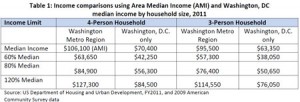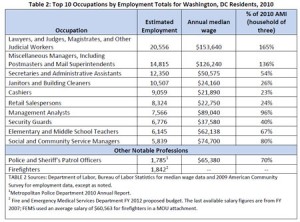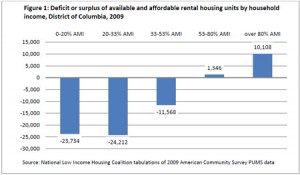One of Mayor Vincent Gray’s stated priorities is to increase the supply of workforce housing, one component of affordable housing needed along the continuum of affordable housing needs. This is a laudable goal — seeking to make DC a place where residents can afford to live close to their jobs. However, if D.C. officials use regional incomes to define “workforce housing,” they will fail to reach most of DC’s low and moderate-income working households. Focusing assistance on households earning below 80 percent of Area Median Income (AMI), or $84,900 for a family of four, better meets the need of the typical DC working family than pegging programs to our wealthy region’s high area median family income.
A Regional Standard Wouldn’t Serve DC’s Local Workforce
While there is no one definition for workforce housing, the Urban Land Institute’s (ULI) Terwilliger Center for Workforce Housing describes it as “housing that is affordable to households earning 60 to 120 percent of the area median income.” In the DC area, this would mean housing that is affordable for a family of four with annual earnings between $63,600 and $127,300. Such a definition appears to not recognize that people earning DC’s minimum wage ($17,160 a year for full time work) are also part of the workforce because the term workforce housing is often used (incorrectly) to refer to households earning above a low-income threshold.
DC has yet to set a clear standard for what workforce housing is, but in the past, the District has used 120 percent of AMI, or $127,300 for a family of four, as the upper limit. More often, developers will use the upper limit of any affordability range to price rents. In 2006, the District created a workforce housing land trust that helps build affordable homes for households earning up to 120 percent AMI. In another instance, the District approved changes to the affordability requirements for the Southwest Waterfront development public land deal. Previously, the affordable housing to be built on site was intended to be affordable to low to moderate-income households, or those earning between $31,830 (30 percent of AMI) and $63,600 (60 percent AMI). The approved changes limited the affordable housing to those households earning between 30-60 percent of AMI to the first 500 units built out of a total of 1,200-1,500 units (or 8-15 percent of all units). The developer was then allowed to fulfill the remainder of the affordable housing requirements by providing units affordable to those earning 100 percent to 120 percent AMI, which the developer termed workforce housing.
Based on regional income definitions, which includes surrounding counties in Maryland and Virginia, most working households in DC would not earn enough to qualify for a program to assist families earning 100 percent of the AMI, let alone the $127,300 a year, or 120 percent of AMI. This is because the District’s median income for a family of four is much lower, $70,400 — or equivalent to just 66 percent of AMI.
Who is the Typical DC Working Household?
Occupations with modest annual wages make up most of the District’s workforce. The income disparities between DC and the larger metro region are evident in Table 1 which compares the area median income (AMI) with median income numbers for District households. 
Working families who wouldn’t be helped by an income standard set at 100 percent AMI include the elementary school teacher and her two children living on an annual income of $62,138 a year, or two working parents such as a security guard and a retail sales clerk earning a combined income of just over $60,000 a year. When we look at the earnings of common occupations in DC (Table 2) — teachers, janitors, security guards, and even police officers — we see that a three-person household with one wage earner for these occupations falls well below 80 percent of AMI. After high-earning lawyers and managers, six of the remaining eight top jobs for DC residents fall below 80 percent AMI, with many falling far below.
DC Workforce Housing Need vs. Availability
An analysis done by the National Low-Income Housing Coalition shows that the District had a surplus of affordable and available housing units, citywide, for those households earning above 80 percent of AMI (Figure 1). This indicates that 80 percent of AMI should be a logical upper limit for targeting affordable housing assistance. The greatest shortages, and greatest housing needs, are found at the lower-income levels, at half of AMI and below. For households earning between 53 and 80 percent AMI, a small surplus exists of units that are both affordable (rent is no more than 30 percent of income) and available (not occupied by a higher income group).
The Fix: Set DC’s Workforce Housing Standard Upper Limit at 80 Percent AMI
The greatest housing challenges by any measure — cost burden, shortage, availability — are faced by DC residents earning well below 60 percent AMI. Thus, programs for the lowest income households should be strengthened. Beyond that, as the District seeks to keep more working households in the city, DC should focus assistance below 80 percent AMI ($76,400 for a family of three), so typical working DC families can be helped. With limited housing aid available, it needs to be used more wisely to help struggling DC working families find a home they can afford.


